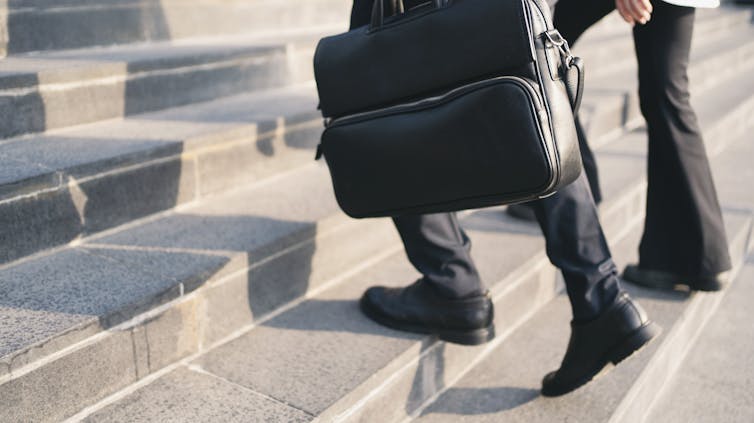Here’s how a ‘silent’ tax hike is balancing the budget – with the heaviest burden on the lowest paid
- Written by Chris Murphy, Visiting Fellow, Economics (modelling), Australian National University

With just over three weeks to go until the federal election, both major parties are trying to position themselves as Australia’s better economic managers.
Labor was able to hand down two consecutive budget surpluses in its current term. But the most recent federal budget[1] shows a return to deficit this financial year.
After the deficit peaks – at 1.5% of gross domestic product (GDP) next financial year – it will then take a decade to balance the budget. My own economic forecasts[2] also imply the budget can return to balance in this time frame.
However, this slow budget repair work is done silently by “bracket creep[3]”, not by policy actions of the government.
Under a progressive tax system, as incomes rise with inflation, the additional income is taxed more heavily.
For example, a worker on average, annual wages of A$79,000 pays 20.3% of that in tax. But they pay tax of 32% (including the medicare levy) on any wage increases, even if those wage increases are only just enough to keep pace with inflation.
The higher tax rate on additional wages pushes up average tax rates – known as bracket creep. This piece[4] explains it well.
Bracket creep has the political advantage of being a silent way of gradually increasing average tax rates. Both major parties are heavily relying on it. But is it good economic policy?
The ‘silent’ tax hike
Though Australia’s personal income tax system is progressive, it’s possible to work out the average tax rate faced by Australians collectively. This is total personal income tax paid as a percentage of total taxable income.
In the first two decades of this century, personal income tax accounted for an average of 22.9% of taxable incomes. There was no clear trend.
Since then, the trend has been up, because announced tax cuts haven’t been enough to offset silent bracket creep.
The average tax rate this financial year, 2024-25, is estimated to be 24.3%.
In the latest budget, the government reduced the lowest marginal tax rate – from 16% to 15% in 2026-27, then to 14% in 2027-28 and beyond.
This almost stabilises the average tax rate for two years. However, it then resumes its upward trend under the silent influence of bracket creep, reaching 28.1% in 2035-36.
This will be an all-time high average tax rate. Living standards will be squeezed and incentives to work and save will diminish.
Some countries limit bracket creep by indexing personal income tax brackets to price inflation. This stops price inflation alone pushing workers into higher tax brackets.
To illustrate how indexing could work, if inflation was 2%, all of the tax thresholds would move up by 2%. For example, the tax free threshold of $18,200 would increase to $18,564.
A worker whose pay had increased by 2% would similarly pay only 2% extra tax, keeping their average tax rate unchanged.
However, most of the time wages rise faster than prices because of productivity growth.
Why bracket creep is unfair
The unfairness of bracket creep can be illustrated with examples.
Under the budget, the average rate of tax (for everyone) rises over the next 11 years by 3.8% points of income.
The average wage earner[6] with an annual income of $79,000 fares a little better. Their average tax rate goes from 20.3% in 2024-25 to 23.6% in 2035-36, an increase of 3.3% points of income, as noted in the recent budget.
However, a low wage earner, with an annual income of $45,000 fares worse. Their average tax rate jumps from 10.8% to 17.3%, an increase of 6.5% points of income.
Do we think it is fair that someone with an annual income of only $45,000 today should have to pay about 17% of their income in income tax in 11 years time?
While this is an extreme example, it illustrates the fact that bracket creep is regressive and has serious unintended consequences.
Less of a “Robin Hood” effect
All of this has implications for the fairness[7] of our tax system overall.
To measure how much a country’s personal income tax system reduces inequality in income distribution, economists use something called the “Reynolds-Smolensky redistribution index”. Let’s call it the “R” index.
A higher R index for a country means a stronger “Robin Hood” element in its tax system – that the system is doing more to redistribute income.
The International Monetary Fund reports[9] that in 2018, the R index for Australia was 6.8%, compared to the average for OECD countries of under 5%. In 2024-25, the Australian R index is already a little lower at 6.5%.
The R index can also be used to measure how benefits reduce inequality, but here, we’re only using it for personal income tax.
Without any budget measures, the regressive nature of bracket creep would have caused the R index to fall further to a value of 6.3% in 2035-36.
However, this budget’s “top-up tax cut” to the lowest marginal tax rate limited this fall to 6.4%, because it was a progressive tax change.
Time for indexation
Politicians from both major parties should stop relying so much on their silent partner, bracket creep, to slowly repair budget deficits.
Instead of misleading announcements of tax cuts in only some budgets, my modelling shows how we could benefit from automatically indexing the tax brackets to prices in every budget.
This will mean that the average rate of personal income tax will rise more modestly over the next 11 years, from 24.3% to 25.5%, instead of to 28.1%. Indexation also limits the fall in the R index to a value of 6.4%.
The resulting revenue shortfall could be filled in ways that are more transparent, efficient and fairer than bracket creep.
Possible ways include better priorities and higher efficiency in government spending, more reliance on indirect taxes such as the GST and expanding the tax base itself through reforms to boost productivity.
References
- ^ federal budget (budget.gov.au)
- ^ economic forecasts (www.austaxpolicy.com)
- ^ bracket creep (theconversation.com)
- ^ piece (theconversation.com)
- ^ Lukas Coch/AAP (photos.aap.com.au)
- ^ average wage earner (budget.gov.au)
- ^ fairness (www.pbo.gov.au)
- ^ muse studio/Shutterstock (www.shutterstock.com)
- ^ reports (www.imf.org)
Authors: Chris Murphy, Visiting Fellow, Economics (modelling), Australian National University







